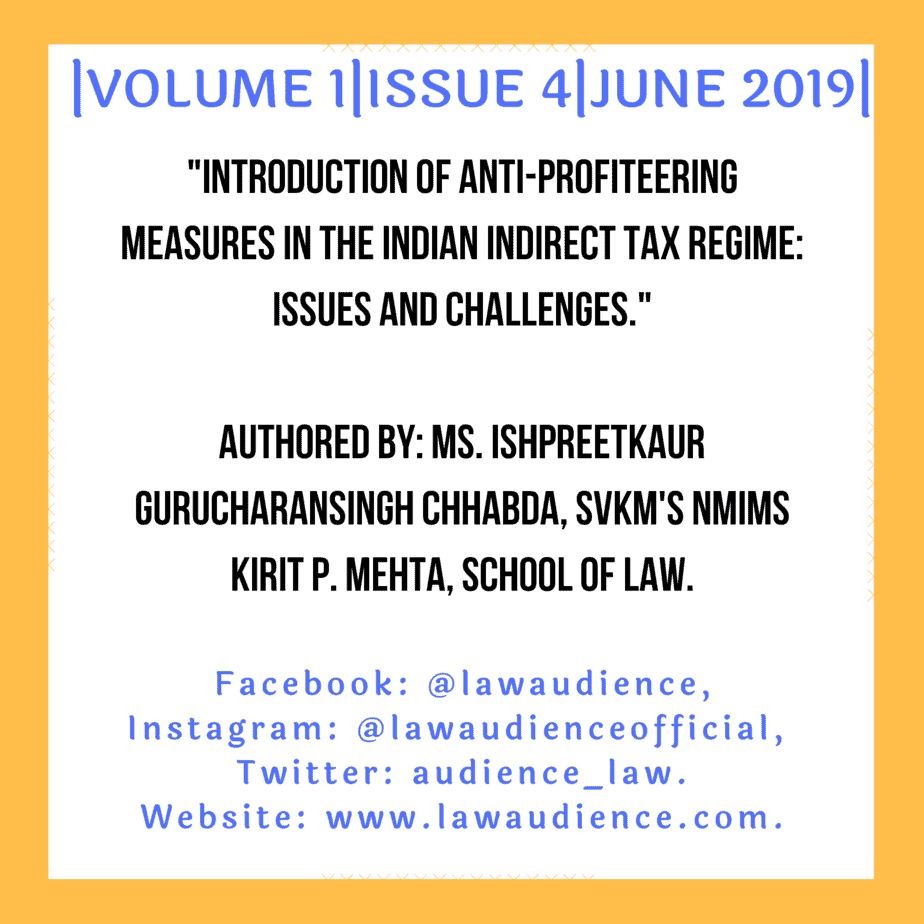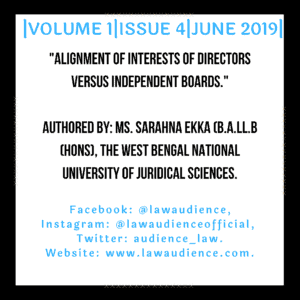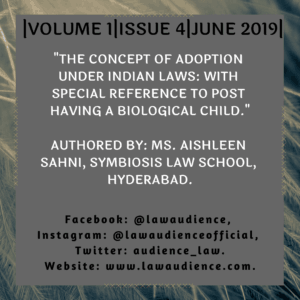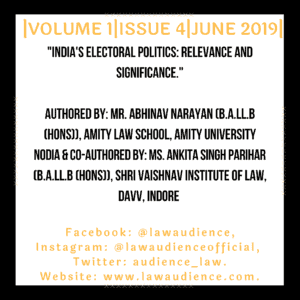Authored By: Ms. Ishpreetkaur Gurucharansingh Chhabda, Svkm’s Nmims Kirit P. Mehta, School of Law.
I. ABSTRACT:
“The introduction of Goods and Service Tax (GST) has been perceived as the biggest tax reform in India. It is a step towards a more comprehensive, efficient and transparent taxation system. To ensure that the consumers reap the benefits of the GST sown by the government, the Anti-profiteering measures were introduced in the Central Goods and Service Tax (CGST) Act and CGST Rules. With the lack of definition of profiteering in the Anti-profiteering legislation and ambiguity in the mechanism to calculate profiteering, questions are being raised on enforcement of these Anti-profiteering measures. Further, there is a lack of appellate mechanism in the legislation, a series of cases filed in the High courts have highlighted loopholes such as factorisation of merely the benefits of Input tax credit and reduced tax rates while disregarding other factors such as the benefits arising from refunds, other tax adjustments and lack of methods to pass the benefits other than price reduction. On the other hand, drawing a parallel with Malaysia, it can be seen that the Anti-profiteering laws in Malaysia are equipped enough to factor in all the elements for determination of profiteering with detailed mechanisms and formulas and proper appellate remedies in place, leaving no room for uncertainties. The purpose of this article is to analyse the ambiguity and loopholes in India’s Anti-profiteering laws and to draw a comparison with the Anti-profiteering laws of Malaysia.”
Keywords: Goods and Services Tax; National Anti-profiteering Authority; Anti-Profiteering.
II. INTRODUCTION:
Goods and Service Tax (‘GST’) is a consumption-based tax and is based on the principle of value-added tax. Till date, more than 160 countries around the world have implemented GST[1] with India very recently adopting a dual GST model. In order to provide a more comprehensive, efficient and transparent taxation system, the idea of adopting GST was proposed back in 2006 by the then Union Finance Minister, P Chidambaram.[2] Although he proposed first of April, 2010 as the date for introducing GST, it took India about a decade to implement the proposed idea.
The Constitutional (122nd Amendment) Bill was passed by the Lok Sabha and the Rajya Sabha on 8th August 2016 and 3rd August 2016 respectively and was notified as Constitution (101st Amendment) Act 2016 on 8th September, 2016 after the receipt of ratification by the required number of State legislatures and assent of the President.[3] The Constitutional Amendment thus paved way for the introduction of GST in India subsuming various Central taxes such as Central excise duty and Special additional duty and State taxes like Value Added Tax and Sales Tax prevailing in the earlier regime, into GST.
What now needed to be addressed were the issues surrounding the transition from the Service tax regime to the new GST regime. There was an inhibition that there might be an inflation due to the switch to GST which was also highlighted by the Chairman of the Parliamentary Standing Committee on Finance, M Veerappa Moily. One of the major concerns of the public as well as the government was the exploitation of consumers by non-reduction of prices in spite of the reduced GST rates. A glaring example of corruption was seen in the previous regimes during the transition from Sales tax Regime to Value Added Tax. Comptroller and Auditor General of India (CAG), in a study, found 13 such manufacturers who did not reduce their maximum retail price of goods despite of a sharp decline in the rate of tax, thus illegally retaining the benefit of approximately 40 Crores. CAG blamed the weak monitoring and absence of mechanism at the Central level for the same and also suggested the constitution of an efficient mechanism to counter all post GST implementation issues.[4] Thus, to avoid such negative effect, an Anti-profiteering measure was introduced in the form of a provision in the Central Goods and Service Tax Act, 2017 (‘CGST Act’) as well as the Central Goods and Services Tax Rules, 2017 (‘CGST Rules’).
Although the intent behind these provisions is appreciated by the author, what is questioned is their enforcement due to the lack of a clear mechanism. The author in this article analyses the Anti-profiteering provisions of the CGST Act as well as CGST Rules to highlight the loopholes in these legislations and their implementation and also provides an international perspective to the issue by drawing a comparative analysis with the antiprofiteering laws of Malaysia.
III. THE ANTI-PROFITEERING MEASURE: ISSUES AND CHALLENGES:
The Anti-profiteering measure was introduced in the CGST Act through Section 171. The said Section mandates the passing of benefits of input tax credit or reduced tax rate by the way of commensurate reduction in prices. It also provides the Central Government, the power to constitute or empower an Authority, on recommendations of the Goods and Service tax Council. The function of such Authority is to examine and enforce such passing of benefits as provided in the Section. Further, Rules 122 to 137 of the CSGT Rules provide for the Constitution, powers and functions of the Authority as constituted or appointed under Section 171 of the CGST Act. National Anti-Profiteering Authority (‘NAA’) as provided for under Section 171 of CGST Act, was approved by the Central Government and established in November of 2017.[5] Union Cabinet chaired by the Prime Minister decided for the appointment of a Chairman and Technical Members of the Authority.
The author shall now highlight the loopholes subsisting in the provisions and the implementation of the same by NAA:
III.I ONLY ONE MODE PRESCRIBED FOR PASSING ON THE BENEFIT:
As seen from the bare reading of the provision, it provides only one mode to pass on the benefit, i.e., reduction in prices. If any other method is adopted to pass on the benefit, the same transaction of the entity shall still be questioned for profiteering.
An example of this is passing on the benefit in the form of increased grammage. Offering more quantity for the price of a much lesser quantity, for example, buy one get one free, has been a prevalent trade practice in the Fast-Moving Consumer Goods (‘FMCG’) Companies (also known as Consumer-Packaged Goods Companies). This also saves on the resources of the company to change the Maximum retail price (‘MRP’) every time there is a change in tax rate or input tax credit.
Further, there are certain products for which reducing the prices are not possible. We can take the example of a candy of MRP Rs. 1/-. A reduction in tax rate suppose demands a reduction of the price of this candy to 0.94 paisa, the price of such candy will be rounded off to 0.50 paisa due to statutory requirements. This is because Rule 2(m) of the Legal Metrology Rules, 2011 (LM Rules) mandates the rounding off of a fraction of less than fifty paise to the preceding Rupee and fraction of above 50 paise up to 95 paise to 50 paise.[6] This would mean that the company who only manufactures such candy would suffer a loss of 44 paise on every candy which surely cannot be justified under the interpretation of ‘commensurate reduction’ and does not fall in line with the intention of the legislation.
Although recently NAA did allow increasing the grammage instead of a reduction in prices to an FMCG Company, it only did so due to the fact that Anti-profiteering measures have been recently incorporated in tax laws in India. Allowing of such increase in grammage is not a norm but an exception to it. It was also instructed by the NAA to the company that in all the future transactions, the passing of benefit should only be done through the mode of reduction in prices.[7] Thus, a blanket denial to accommodate any method other than price reduction is impractical. Even if the argument that price reduction is the most effective way to pass on the benefits is considered, the legislation should provide for exceptions for cases as such as illustrated in the example above or should provide for flexibility for the Authority to decide on such matters on case to case basis.
III.II SURROUNDING CIRCUMSTANCES NOT FACTORED:
While the computation of profiteering, the only elements considered by the provisions are the tax rates and the input tax credit Pre-GST and Post-GST. The criteria laid down in the section do not factor in other reasons that may contribute to a price rise despite the reduction in tax rates like change in the price of raw materials or an event of force majeure.
For example, a loaf of bread was sold in the market in the pre-GST regime at MRP Rs 30/- (Rs. 25/- for raw materials and labour and Rs. 5/- as taxes). In the GST regime, suppose the price of one of the raw materials increases by Rs. 4/- and the amount of tax reduces from Rs. 5/- to Rs. 2/- (by Rs. 3/-), the ultimate cost to the manufacturer thus becomes Rs. 31/- (Rs. 29/- as cost of raw materials and labour and Rs. 2/- as taxes). In spite of this, the provisions merely factor the tax rate and thus demand the manufacturer to reduce the price from Rs. 30/- (pre-GST regime cost) to Rs. 27 (factoring in the Rs. 3/- reduction in tax amount) while the actual cost to the manufacturer without gaining any additional profits is Rs. 31/-. This is coercing the traders and the manufacturers to either suffer a loss or face penalty for profiteering.
Further, even if we count on the NAA to fill in this gap in the provisions, there has been no uniformity in its decisions regarding factorisation of costs during the Computation of profiteering. On one hand, in Kumar Gandharv v. KRBL Ltd., the NAA held that increase in the price of India Gate Basmati Rice due to the imposition of GST and the increased purchase price of paddy does not amount to profiteering[8], and on the other hand, in Sukhbir Rohilla v. Pyramid Infratech (P.) Ltd.[9], it did not factor the increased price of steel as raw material for construction while computation of profiteering.
Thus, unless there are clear criteria laid down for considering various elements while computing Anti-profiteering, there shall be no uniformity in the decisions which will lead to a negative impact on the businesses.
III.III MECHANISM FOR COMPUTATION OF ‘COMMENSURATE REDUCTION’ NOT PROVIDED:
Section 171 of CGST Act mandates the passing of benefits by a commensurate reduction in prices but it does not provide any mechanism for computation of such ‘commensurate reduction’. There is no uniformity currently in the industry regarding how to calculate the benefit to be passed. Further, the term profiteering is not defined anywhere which adds to the vagueness of the provisions and keeps it wide enough to address situations where traders are only profiting and not profiteering. Further, Rule 126 of CGST Rules gives NAA the power to determine the methodology and procedure that governs whether the reduction in the rate of tax on the supply of goods or services or the benefit of the input tax credit has been passed on by the registered person to the recipient by way of commensurate reduction in prices. Clearly, this power has not materialised in any concrete methodology yet. Further, the language used in the said Rule is that the “The Authority may determine the methodology and procedure…’ which gives the NAA the flexibility to not provide any methodology and procedure.
III.IV ABSENCE OF AN APPELLATE BODY:
The term ‘Adjudicating Authority’ does not include under its ambit, the authority constituted or assigned under Section 171 of CGST Act i.e. NAA[10]. Thus, an appeal against an order of NAA cannot be filed before Appellate Authority or Appellate Tribunal. Further, there is no appellate mechanism or authority prescribed against an order of NAA and no provision that such order can be challenged by the way of an appeal before any tribunal, High Court or Supreme Court has been provided. Thus, the only remedy with a person dissatisfied with the NAA order is to approach the High Court through a Writ Petition.
An issue surrounding the remedy of Writ Petitions is its jurisdiction to entertain questions of facts. While it has been held by the Apex Court that the High Court is duty bound to consider the involvement of any complex and disputed question of facts and their resolvability and availability of alternative or effective remedy for resolution of dispute[11], where an enquiry into complicated questions of facts arises, the High Court has the discretion to not entertain such questions of facts.[12] Profiteering matters need dwelling into the computations and technical knowledge around such computations. With regards to the recent profiteering matters, the High Courts have shown hesitance to entertain these computations.
Meanwhile, if an Appellate Authority is constituted or there is a provision made to challenge the NAA order before any tribunal, High Court or Supreme Court, the consideration of questions of facts is mandatory. The first appeal has to be decided on facts as well as law. In the first appeal, parties have the right to be heard on questions of law as also on facts and the first appellate court is required to address all the issues and decide the case by giving reasons.[13]
III.V CONSTITUTIONAL VALIDITY OF ANTI-PROFITEERING PROVISIONS:
While price fixation[14] and economic stability[15] have been held as reasonable restrictions to freedom of trade and commerce, only essential commodities can fall under the ambit of such restrictions. The power provided to NAA to decide anti-profiteering measures without providing any proper guidelines has led to the blurring of lines between two very different concepts of ‘profiting’ and ‘profiteering’. This has provided NAA, with the flexibility to decide the maximum price of non-essential commodities as well without taking into account the reasonable right of the traders to decide the price of their own goods. Thus, the author is of the opinion that lack of a proper mechanism factoring the reasonable profit earned by the businesses is violative of their freedom of trade and commerce.[16]
IV. COMPARATIVE STUDY WITH MALAYSIA:
One of the objectives to introduce GST in Malaysia was to tackle the budget deficit and economic recession.[17] The Malaysian government enforced the Price Control and Anti- Profiteering Act (PCAPA), 2011 to avoid any exploitation or manipulation by businesses of transitioning to GST and to curb profiteering.[18]
The PCAPA 2011 aims to ensure that there is no unreasonable increase in prices of goods and services due to the implementation of GST in Malaysia[19]. Under PCAPA 2011, it is an offence to make an unreasonably high profit from the sale or supply of goods and services in the course of trade or business. [20]
Further, PCAPA 2011 requires adherence to the regulations, to pass on the full effect of cost savings from any tax adjustments, to account for any Sales tax Refund claimed which should be excluded from the material cost and to ensure that benefit of the Input tax credit is passed on. Clearly, while India’s intention for formulation of Anti-profiteering laws is similar to that of Malaysia i.e. for passing the benefits to the ultimate consumer, the laws in India have merely factored in the benefits of Input tax credit and reduced tax rates and failed to acknowledge benefits arising from refunds, other tax adjustments and other such factors.
The PCACA 2011 also defines “profiteer” as making profit unreasonably high,[21] as opposed to India where the CGST Act, as well as the Rules, are silent on the definition leaving the ambit wide and vague.
Further, while the NAA in India has been given the discretion to provide for a mechanism and procedure, the minister under PCAPA 2011 is mandated to prescribe the mechanism to determine when the profit is unreasonably high. He is also given the flexibility to prescribe different types of mechanism to cater for different conditions and circumstances as he deems fit. The minister has to factor in certain elements such as costing, supply and demand, conditions of the geographical or product market and the corresponding imposition of any taxes while formulating the mechanism.[22]
Meanwhile, the Indian framework does not accommodate these important factors while computing Anti-profiteering. Various Writ Petitions have been filed by Indian traders contending the non-factorisation of an important factor like increased cost of raw materials while computation of profiteering by the NAA is an infringement of their fundamental rights.[23]
To determine the unreasonably high profits, Price Control and Anti-Profiteering (Mechanism to Determine Unreasonably High Profit) Regulations 2018 (Regulations of 2018) under PCAPA 2011 was gazetted on 5 June 2018 by the Malaysian government. The Regulations of 2018 supplement the provisions of the PCAPA 2011 in respect of the offence of profiteering.
Regulations of 2018 provide for two main mechanisms to determine “unreasonably high profits”, either based on the mark-up percentage of the goods sold or offered for sale or services supplied or offered for supply, or based on the margin percentage of the same. The mark-up percentage is calculated by taking into account the sales price less the cost price, divided by the cost price using a percentage basis. While the margin percentage is calculated by taking into account the sale price less the cost price, divided by the sale price using a percentage basis.[24]
In addition to this, detailed formulas to assist the computation of Antiprofiteering under these mechanisms have also been provided in the Regulations of 2018. On the other hand, the Indian framework has not provided any mechanism or procedure for computation of Anti-profiteering and thus there is no clarity or uniformity among various businesses and traders regarding the same.
Further, the PCAPA 2011 provides for the jurisdiction of the Sessions Court to try any offence. The Appeal from such subordinate court is presided by the High Court of Malaysia.[25]While in India, the NAA has the authority to investigate and preside over profiteering matters with no Appellate mechanism and with writ petitions being the only alternative remedy.
V. CONCLUSION AND SUGGESTIONS:
It is said, “Measure twice, cut once”. While it is true that as a matter of right, beneficiaries are entitled to the tax benefits, creation of an Authority to protect such a right, with a vague legislation and absence of prescribed guidelines may prove to be counterproductive. The Anti-profiteering measure was incorporated in the CGST Act as a lesson learnt from the earlier regimes. Yet, in spite of holding the noble intention of protecting the ultimate consumers, it has been blamed to be a political gimmick which can be a cause of tremendous harassment to a taxable person.[26] The apparent lack of definition of ‘profiteering’ and the absence of a mechanism for computation of commensurate price reduction has led to the uncertainties in the decisions of the NAA, with no appellate remedy provided for the aggrieved taxpayers.
Further, Non-factorisation of surrounding circumstances like the price of raw materials or an event of force majeure and non-flexibility in the legislation to pass on the benefits to the consumers through any other mode is proving to be a hindrance for the businesses and is clearly against India’s promoted principle of ‘ease of doing business’.
Meanwhile, Anti-profiteering laws in Malaysia are equipped enough to factor in all the elements for determination of profiteering with detailed mechanisms and formulas and proper appellate remedies in place, leaving no room for uncertainties. India has a long way to go in terms of learning from this jurisdiction and adapting according to its need.
With more than a year into GST and NAA blurring the lines between profit and profiteering, it is high time for India to bring Amendments to the Anti-profiteering measures and give ‘great responsibilities’ to this Authority holding ‘great powers’.
[1]Treasury.gov.my. (n.d.). List of Countries Implementing VAT/GST. [online] Available at: http://www.treasury.gov.my/pdf/gst/list_of_countries.pdf [Accessed 14 Jan. 2019].
[2] Indiabudget.gov.in. (2006). Government of India : Union Budget and Economic Survey. [online] Available at: https://www.indiabudget.gov.in/ub2006-07/bs/speecha.htm [Accessed 14 Jan. 2019].
[3] www.gst.gov.in. (n.d.). Goods and Services Tax. [online] Available at: https://www.gst.gov.in/about/gst/history [Accessed 14 Jan. 2019].
[4] Comptroller and Auditor General of India (2010), Implementation of value added tax in India: lessons for transition to goods and services tax: a study report 2010. p.vii-viii.
[5] Cabinet approval to anti-profiteering authority may ensure GST benefits to consumers, Business Today (2017), https://www.businesstoday.in/current/economy-politics/gst-national-anti-profiteering-authority-naa-benefit-customers-business/story/264174.html (last visited Jan 14, 2019).
[6] The Legal Metrology (Packaged Commodities) Rules, 2011, §. 2(m) (India).
[7] Ankit Kumar Bajoria & Ors. vs. M/s Hindustan Unilever Ltd., (2018) 12 TMI 1599.
[8] Kumar Gandharv v. KRBL Ltd., (2018) 5 TMI 760.
[9] Sukhbir Rohilla v. Pyramid Infratech Pvt. Ltd., (2018) 19 G.S.T.L. 65.
[10] Central Goods and Service Tax Act, 2017, NO. 12 of 2017, §. 2(4) (India).
[11] City and Industrial Development Corpn. v. Dosu Aardeshir Bhiwandiwala, (2009) AIR SC 571.
[12] State of Orissa v. Binapani Dei and Ors. (1967) AIR SC 1269.
[13] H.K.N. Swami v. Irshad Basith (dead) by LRS. (2005) 10 SCC 243.
[14] ONGC v. Association, N.G.C., Supp. (1990) SCC 397.
[15] State of Assam v. Srisitkar Dowerah, (1957) AIR SC 414; Glass Chatons Importers and Users Association v. Union of India, (1961) AIR SC 1514.
[16] INDIA CONST., art. 19.
[17] Margaret Ang Guat Hee & Laksme Khorana, An Assessment of the Introduction of Goods and Services Tax in Malaysia and its Implications on the Merchant Shipping Sector and Maritime Supply Chain, mima.gov.my (14, Jan. 14,2019, 9:45 AM), http://www.mima.gov.my/mima/wp-content/uploads/gst%20-%20final%20report%2020jul10.pdf .
[18] Siaw Yan-Li, Investigating Price Control and Anti-Profiteering Regulation: Tackling the GST Pricing Issue, 8(2) Business and Management Quarterly Review, 53, 54 (2017).https://umexpert.um.edu.my/file/publication/00014078_159125_74753.pdf.
[19] Bakermckenzie.com. (2016). Anti Profiteering Malaysia – Proposal to introduce new anti-profiteering mechanism. [online] Available at: https://www.bakermckenzie.com/-/media/files/insight/publications/2016/06/anti-profiteering-malaysia-proposal-to%20introduce/anti_profiteering_malaysia__proposal_to_introduce_new_anti_profiteering_mechanism.pdf?la=en [Accessed 13 Jan. 2019].
[20] Price Control and Anti Profiteering Act, 2011 §. 14 (Malaysia).
[21] Ibid.
[22] Price Control and Anti Profiteering Act, 2011 §. 15 (Malaysia).
[23] M/S Pyramid Infratech Private Ltd. v. Union Of India & Ors. (2018) W.P.(C) 10999.
[24] Bakermckenzie.com. (2018). Malaysia Anti Profiteering Update: Introduction of 2018 Mechanism to Determine Unreasonably High Profits | Insight | Baker McKenzie. [online] Available at: https://www.bakermckenzie.com/en/insight/publications/2018/06/anti-profiteering-update-malaysia [Accessed 14 Jan. 2019].
[25] Courts of Judicature Act, 1964 §. 27 (Malaysia)
[26] V.S. DATEY, GST READY RECKONER, 793 (8th ed. 2018).



